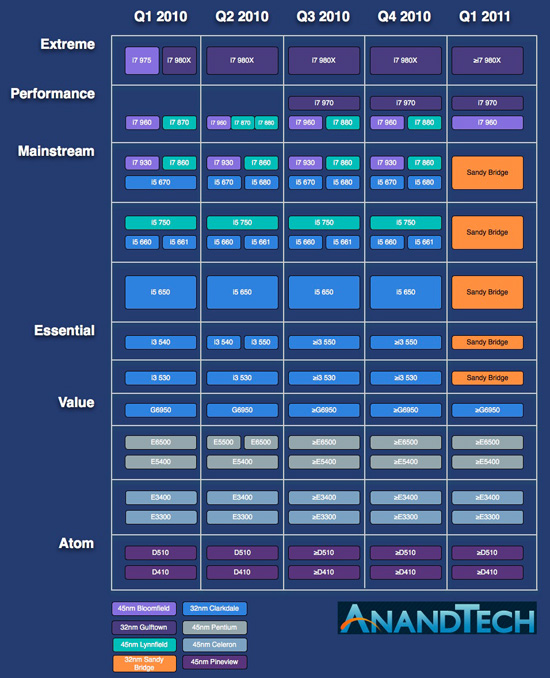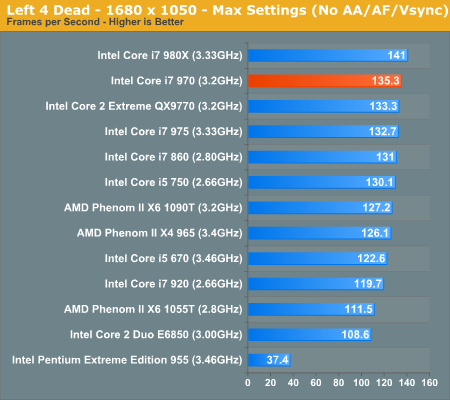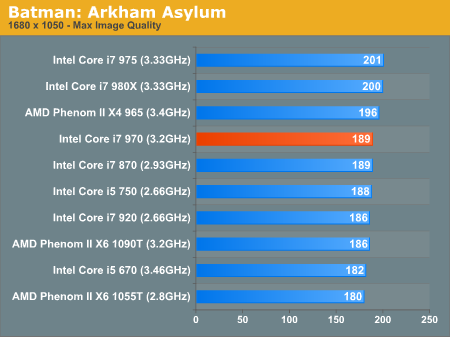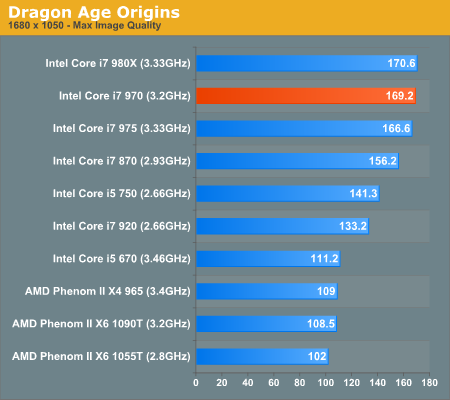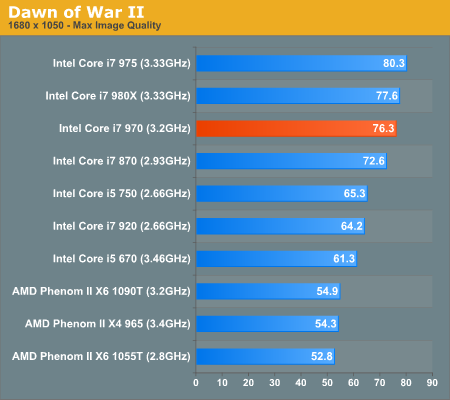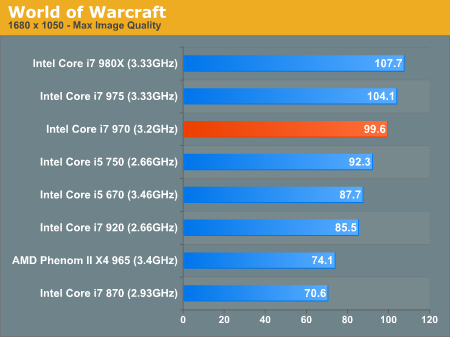
Original Link: https://www.anandtech.com/show/3833/intels-core-i7-970-reviewed-slightly-more-affordable-6core
Intel's Core i7 970 Reviewed, (Slightly) More Affordable 6-core
by Anand Lal Shimpi on July 29, 2010 3:23 AM EST
I ran into an old friend of mine who happens to work for Intel at an industry event last month. We were naturally talking about Intel when he pointed out that the company was doing very well. I agreed, but argued that Intel’s progress was being artificially limited by the fact that it wasn’t facing much competition at the high end.
It’s true. AMD’s entire desktop product line exists below $300, and we won’t see a real push for the high end crown until next year with Bulldozer. Until then, the real competition happens at lower (and arguably more interesting) price points where AMD gives you more cores for less, while Intel offers lower power consumption and better single threaded performance.
The ultra high end is still alive and well, despite the lack of competition in the market. Apple just announced its own dual-socket, 12-core monster that will begin shipping next month. Even Intel will tell you that it’s seeing more interest in the Core i7 980X than any previous Extreme Edition part. And the interest isn’t misplaced.
As the first 6-core desktop CPU based on Intel’s 32nm Gulftown core, the Core i7 980X was the first Extreme Edition in years to offer more than just a clock speed advantage. You got more cores, a larger L3 cache and virtually the highest clock speeds Intel has to offer. If you run highly threaded workloads, you can’t do any better on the desktop today. Thanks to its turbo modes, you don’t even give up performance in lightly threaded apps either.
The 980X of course carried an extreme price tag at $999. With more competition at the high end we might’ve seen derivative parts offered at lower clock speeds and lower price points. But until AMD delivers Bulldozer the impetus just isn’t there. Instead what we’re left with is a slow moving waterfall.
Early next year (Q1) Intel will introduce the Core i7 990X, a clock bumped version of the 980X. Presumably the 990X will run at 3.46GHz by default, but have the ability to turbo up even higher. The roadmap calls for another clock bump in Q2 depending on what AMD does.
Below the 980X there’s only a single 6-core desktop part for at least the next 6 months: the Core i7 970.

Its unassuming name implies little more than just a faster Core i7, however its $885 (1000 unit quantities) pricetag says otherwise. While the rest of the desktop Core i7 line is made up of 45nm quad-core Bloomfield and Lynnfield processors, the Core i7 970 is a 32nm 6-core Gulftown.
| Processor | Core Clock | Cores / Threads | L3 Cache | Max Turbo | TDP | Price |
| Intel Core i7 980X | 3.33GHz | 6 / 12 | 12MB | 3.60GHz | 130W | $999 |
| Intel Core i7 975 | 3.33GHz | 4 / 8 | 8MB | 3.60GHz | 130W | $999 |
| Intel Core i7 970 | 3.20GHz | 6 / 12 | 12MB | 3.46GHz | 130W | $885 |
| Intel Core i7 960 | 3.20GHz | 4 / 8 | 8MB | 3.46GHz | 130W | $562 |
| Intel Core i7 930 | 2.80GHz | 4 / 8 | 8MB | 3.06GHz | 130W | $284 |
| Intel Core i7 880 | 3.06GHz | 4 / 8 | 8MB | 3.73GHz | 95W | $583 |
| Intel Core i7 875K | 2.93GHz | 4 / 8 | 8MB | 3.60GHz | 95W | $342 |
| Intel Core i7 870 | 2.93GHz | 4 / 8 | 8MB | 3.60GHz | 95W | $294 |
| Intel Core i7 860 | 2.80GHz | 4 / 8 | 8MB | 3.46GHz | 95W | $284 |
| Intel Core i5 760 | 2.80GHz | 4 / 4 | 8MB | 3.33GHz | 95W | $205 |
| Intel Core i5 750 | 2.66GHz | 4 / 4 | 8MB | 3.20GHz | 95W | $196 |
| Intel Core i5 670 | 3.46GHz | 2 / 4 | 4MB | 3.73GHz | 73W | $284 |
| Intel Core i5 661 | 3.33GHz | 2 / 4 | 4MB | 3.60GHz | 87W | $196 |
| Intel Core i5 660 | 3.33GHz | 2 / 4 | 4MB | 3.60GHz | 73W | $196 |
| Intel Core i5 650 | 3.20GHz | 2 / 4 | 4MB | 3.46GHz | 73W | $176 |
| Intel Core i3 540 | 3.06GHz | 2 / 4 | 4MB | N/A | 73W | $133 |
| Intel Core i3 530 | 2.93GHz | 2 / 4 | 4MB | N/A | 73W | $113 |
| Intel Pentium G9650 | 2.80GHz | 2 / 2 | 3MB | N/A | 73W | $87 |
Like the 980X, the Core i7 970 has a 12MB L3 cache that’s shared by all six cores, all on a single 240mm2 die. The 1.17 billion transistor chip runs at a stock speed of 3.2GHz but can turbo up to 3.46GHz if two or fewer cores are active. With more than two active, and assuming no thermal or current limits are exceeded, the chip can run at 3.33GHz. For around $100 off the price of a 980X you’re not giving up much in terms of clock speed.
The uncore (everything outside of the CPU cores + L2 caches) also remains mostly unchanged. The 970 runs its uncore at 2.66GHz (identical to the 980X) but the QPI bus is stuck at 4.8GT/s vs. 6.4GT/s. The difference isn’t something that will appear in real world performance however.
| CPU | Codename | Manufacturing Process | Cores | Transistor Count | Die Size |
| Westmere 6C | Gulftown | 32nm | 6 | 1.17B | 240mm2 |
| Nehalem 4C | Bloomfield | 45nm | 4 | 731M | 263mm2 |
| Nehalem 4C | Lynnfield | 45nm | 4 | 774M | 296mm2 |
| Westmere 2C | Clarkdale | 32nm | 2 | 384M | 81mm2 |
| AMD Phenom II X6 | Thuban | 45nm | 6 | 904M | 346mm2 |
| AMD Phenom II X4 | Deneb | 45nm | 4 | 758M | 258mm2 |
Overall expect to see very close to 980X performance for $100 less. You lose the unlocked multiplier, which may have some overclocking implications, but that’s about it.
The rest of the Gulftown enhancements still apply. We finally get uncore power gating and AES-NI. The former gives us power consumption equal to 45nm quad-core Bloomfield i7s, while the latter improves encryption performance. Both of which we’ve demonstrated in the past.
BIOS Support and The Test
Any X58 motherboard with Gulftown support should work with the 970. As was the case with the original 980X launch, you’ll almost definitely need an updated BIOS to make this work.
Even Intel’s own DX58SO motherboard using the BIOS that originally enabled 980X support needed an update to work with the Core i7 970. Unfortunately you need to do this update before you install the CPU so make sure your board is up to date.
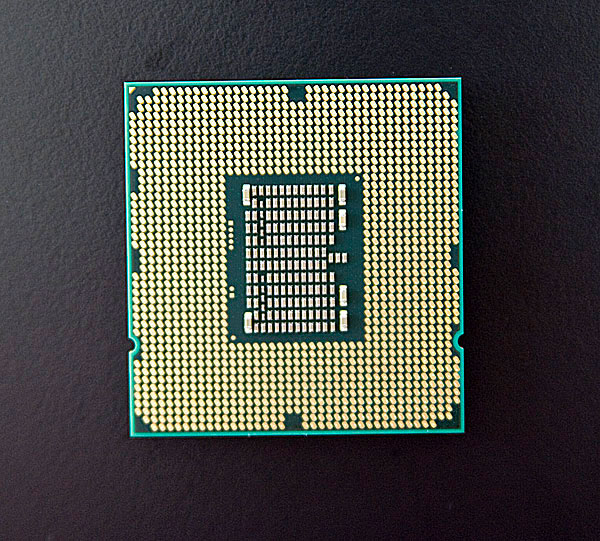
We’ve added the Core i7 970 results to Bench, our benchmark database. The graphs that follow are a subset of those results to keep the article reasonably sized.
| Motherboard: |
ASUS P7H57DV- EVO (Intel H57) Intel DP55KG (Intel P55) Intel DX58SO (Intel X58) Intel DX48BT2 (Intel X48) Gigabyte GA-MA790FX-UD5P (AMD 790FX) MSI 890FXA-GD70 (AMD 890FX) |
| Chipset Drivers: |
Intel 9.1.1.1015 (Intel) AMD Catalyst 8.12 |
| Hard Disk: | Intel X25-M SSD (80GB) |
| Memory: |
Corsair DDR3-1333 4 x 1GB (7-7-7-20) Corsair DDR3-1333 2 x 2GB (7-7-7-20) |
| Video Card: |
eVGA GeForce GTX 280 (Vista 64) ATI Radeon HD 5870 (Windows 7) |
| Video Drivers: |
ATI Catalyst 9.12 (Windows 7) NVIDIA ForceWare 180.43 (Vista64) NVIDIA ForceWare 178.24 (Vista32) |
| Desktop Resolution: | 1920 x 1200 |
| OS: |
Windows Vista Ultimate 32-bit (for SYSMark) Windows Vista Ultimate 64-bit Windows 7 x64 |
SYSMark 2007 Performance
Our journey starts with SYSMark 2007, the only all-encompassing performance suite in our review today. The idea here is simple: one benchmark to indicate the overall performance of your machine.
SYSMark is an example of what a mostly dual-core workload looks like. The 6-core advantage is nil, although the very large L3 cache makes up for it. In this case the Core i7 970 is just slightly slower than the quad-core 975.
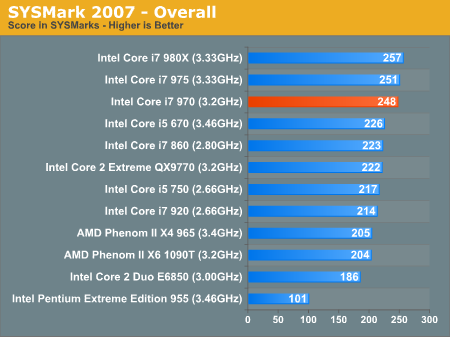
Adobe Photoshop CS4 Performance
To measure performance under Photoshop CS4 we turn to the Retouch Artists’ Speed Test. The test does basic photo editing; there are a couple of color space conversions, many layer creations, color curve adjustment, image and canvas size adjustment, unsharp mask, and finally a gaussian blur performed on the entire image.
The whole process is timed and thanks to the use of Intel's X25-M SSD as our test bed hard drive, performance is far more predictable than back when we used to test on mechanical disks.
Time is reported in seconds and the lower numbers mean better performance. The test is multithreaded and can hit all four cores in a quad-core machine.
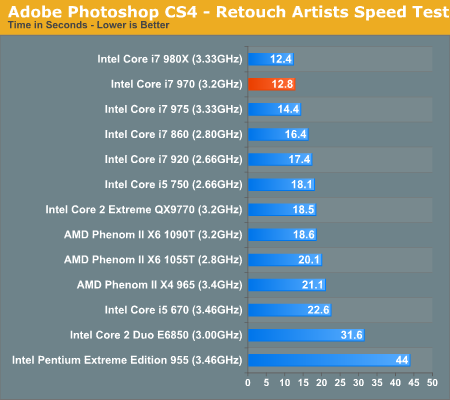
We loved the 980X for Photoshop use when it launched, and the 970 is no different. Photoshop can use the extra cores, although the performance difference isn't huge it's there.
DivX 6.8.5 with Xmpeg 5.0.3
Our DivX test is the same DivX / XMpeg 5.03 test we've run for the past few years now, the 1080p source file is encoded using the unconstrained DivX profile, quality/performance is set balanced at 5 and enhanced multithreading is enabled.
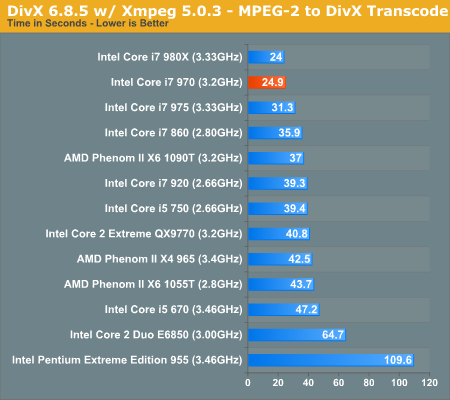
Video encoding is where it's at with the 6-core Gulftown processors. The 970 is hot on the heels of the 980X.
x264 HD Video Encoding Performance
Graysky's x264 HD test uses x264 to encode a 4Mbps 720p MPEG-2 source. The focus here is on quality rather than speed, thus the benchmark uses a 2-pass encode and reports the average frame rate in each pass.
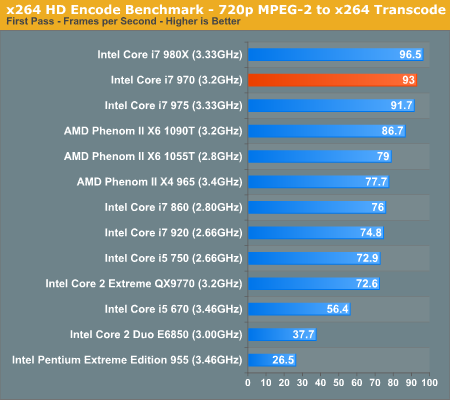

There's no replacement for core count in these heavily threaded workloads. The 970 is over 40% faster than the Core i7 975 and gives you 96% of the performance of a Core i7 980X.
3dsmax 9 - SPECapc 3dsmax CPU Rendering Test
Today's desktop processors are more than fast enough to do professional level 3D rendering at home. To look at performance under 3dsmax we ran the SPECapc 3dsmax 8 benchmark (only the CPU rendering tests) under 3dsmax 9 SP1. The results reported are the rendering composite scores.
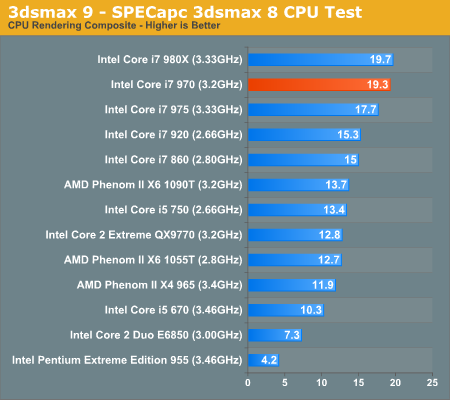
You get 9% better performance than a Core i7 975 and 98% of the performance of the 980X. Not too shabby, but then again you're not saving a ton of money by comparison. The Core i7 970 still costs roughly $900.
Cinebench R10
Created by the Cinema 4D folks we have Cinebench, a popular 3D rendering benchmark that gives us both single and multi-threaded 3D rendering results.
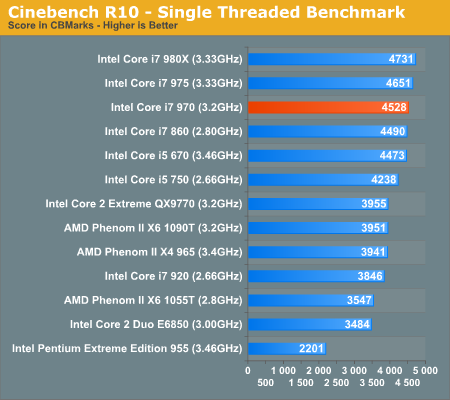
Single threaded performance is very competitive, which is due entirely to Intel's well architected turbo modes. You get a 6-core processor that can act like the fastest single-core CPU on the planet if needed.
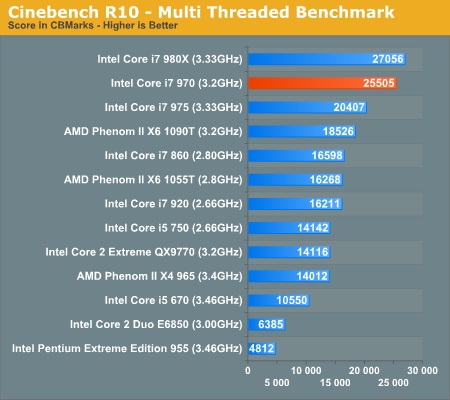
POV-Ray 3.73 beta 23 Ray Tracing Performance
POV-Ray is a popular, open-source raytracing application that also doubles as a great tool to measure CPU floating point performance.
I ran the SMP benchmark in beta 23 of POV-Ray 3.73. The numbers reported are the final score in pixels per second.
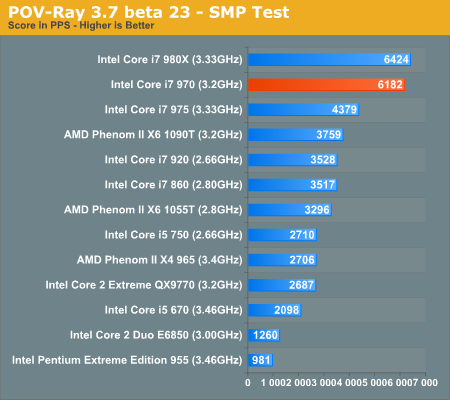
PAR2 Multithreaded Archive Recovery Performance
Par2 is an application used for reconstructing downloaded archives. It can generate parity data from a given archive and later use it to recover the archive
Chuchusoft took the source code of par2cmdline 0.4 and parallelized it using Intel’s Threading Building Blocks 2.1. The result is a version of par2cmdline that can spawn multiple threads to repair par2 archives. For this test we took a 708MB archive, corrupted nearly 60MB of it, and used the multithreaded par2cmdline to recover it. The scores reported are the repair and recover time in seconds.
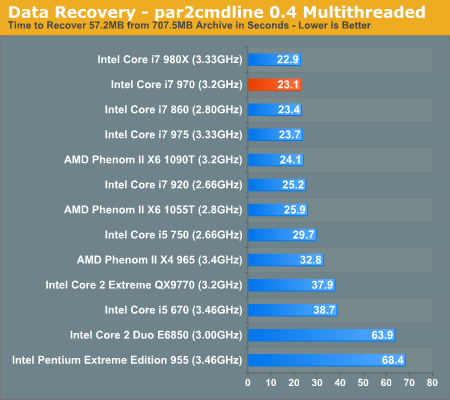
7-Zip Performance
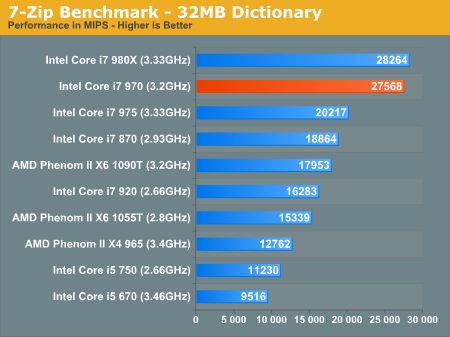
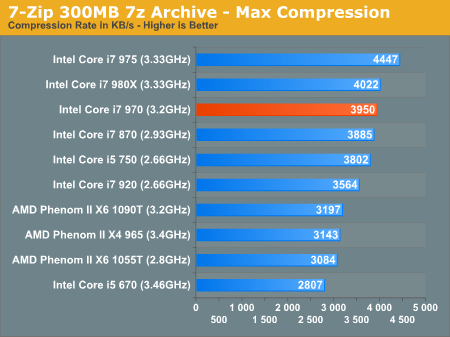
Gaming Performance
If you're building a gaming box there are clearly better options for you. The i7 970 does well here but it's mostly a waste unless you're doing a lot of 3D rendering or video encoding when you're not gaming. Virtually any of these CPUs will do well in today's games as well as tomorrow's.
Power Consumption
Power consumption is about the same as the i7 980X. You get better idle power than any other LGA-1366 CPU thanks to the 32nm transistors, and load power consumption equivalent to the original Nehalem. The Core i7 970 is still a 130W chip, it's by no means cool, but compared to other 130W parts it's quite efficient.
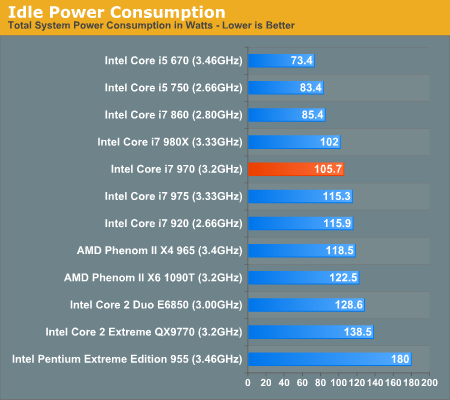
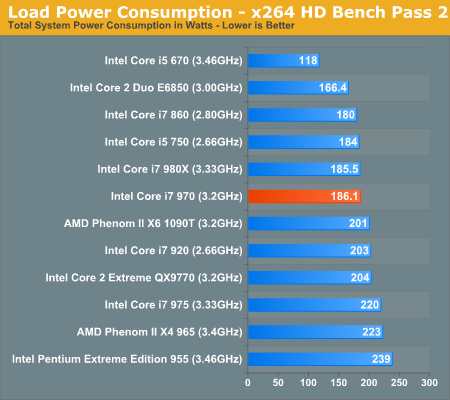
Overclocking
Despite a 50% increase in cores and L3 cache, the 32nm Gulftown parts have proven to be excellent overclockers. I had no problems pushing 4.13GHz on my Core i7 980X a few months ago. The Core i7 970 didn't do quite as well unfortunately. With a 1.40V core voltage I was able to hit 3.96GHz but I couldn't get Windows 7 stable at anything higher.
A 24% overclock isn't bad, but it's just not as good as what we're used to. You may have better luck than I did, however it's also possible that the 970 exists to make use of the Gulftowns that couldn't yield at 3.33GHz. In other words, these parts may just not be as overclockable as the 980X.

Final Words
In March I called the Core i7 980X the first Extreme Edition CPU that I was excited about. Price aside, you make no tradeoffs with the 980X. You get the absolute best performance in heavily threaded applications and nearly the same in all other workloads. Power consumption was also a non-issue, at least compared to last year's 45nm quad-core. Whether or not the 980X was worth it really depended on what sort of applications you're using. If you're doing a lot of 3D rendering, video encoding or other heavily threaded tasks it makes sense. Otherwise, despite the class leading performance, it's not a good value.
Recounting an old conclusion is one of the laziest things I can do as a writer, but I'm doing it here because the very same points hold true to today's Core i7 970. You save $100 and give up unlocked multipliers and a very small amount of performance. If you're going to be running at stock clock speeds, the 970 is a fine way to make the Gulftown jump a little more palatable. If you're planning on overclocking, the 980X may be a better option. The unlocked multiplier helps and you may be able to get a little more headroom out of the 980X if the Core i7 970 is truly just a binned 980X.

Thankfully at these price points there's not much deliberating necessary. You either have the budget for it or you don't. And if you're remotely considering splurging, keep in mind that quad-core will get even faster early next year with Sandy Bridge.
Like the 980X, the Core i7 970 isn't something I'd personally buy simply because of the price. It's a great performer however. For some, that's all that matters. And looking at Intel's roadmap, you won't see a significantly faster 6-core replacement until Q4 2011.

